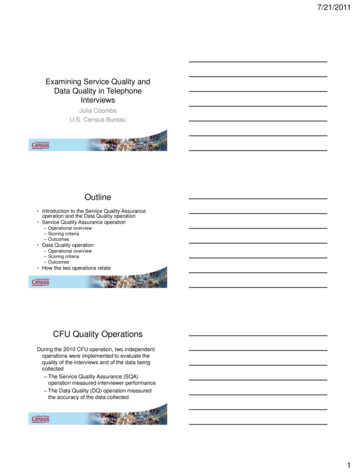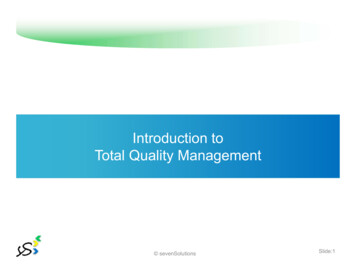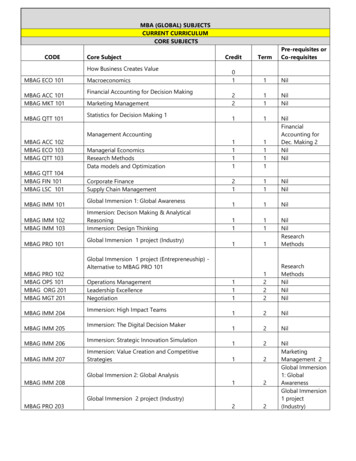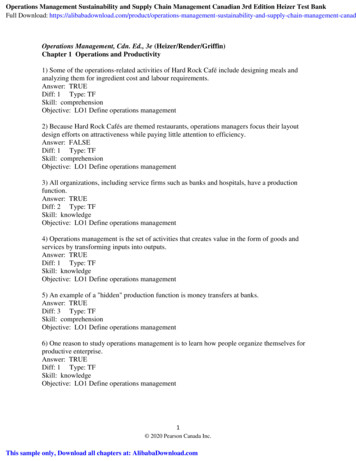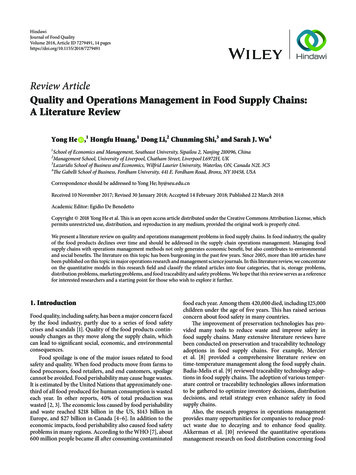
Transcription
HindawiJournal of Food QualityVolume 2018, Article ID 7279491, 14 pageshttps://doi.org/10.1155/2018/7279491Review ArticleQuality and Operations Management in Food Supply Chains:A Literature ReviewYong He,1 Hongfu Huang,1 Dong Li,2 Chunming Shi,3 and Sarah J. Wu41School of Economics and Management, Southeast University, Sipailou 2, Nanjing 210096, ChinaManagement School, University of Liverpool, Chatham Street, Liverpool L6972H, UK3Lazaridis School of Business and Economics, Wilfrid Laurier University, Waterloo, ON, Canada N2L 3C54The Gabelli School of Business, Fordham University, 441 E. Fordham Road, Bronx, NY 10458, USA2Correspondence should be addressed to Yong He; hy@seu.edu.cnReceived 10 November 2017; Revised 30 January 2018; Accepted 14 February 2018; Published 22 March 2018Academic Editor: Egidio De BenedettoCopyright 2018 Yong He et al. This is an open access article distributed under the Creative Commons Attribution License, whichpermits unrestricted use, distribution, and reproduction in any medium, provided the original work is properly cited.We present a literature review on quality and operations management problems in food supply chains. In food industry, the qualityof the food products declines over time and should be addressed in the supply chain operations management. Managing foodsupply chains with operations management methods not only generates economic benefit, but also contributes to environmentaland social benefits. The literature on this topic has been burgeoning in the past few years. Since 2005, more than 100 articles havebeen published on this topic in major operations research and management science journals. In this literature review, we concentrateon the quantitative models in this research field and classify the related articles into four categories, that is, storage problems,distribution problems, marketing problems, and food traceability and safety problems. We hope that this review serves as a referencefor interested researchers and a starting point for those who wish to explore it further.1. IntroductionFood quality, including safety, has been a major concern facedby the food industry, partly due to a series of food safetycrises and scandals [1]. Quality of the food products continuously changes as they move along the supply chain, whichcan lead to significant social, economic, and environmentalconsequences.Food spoilage is one of the major issues related to foodsafety and quality. When food products move from farms tofood processors, food retailers, and end customers, spoilagecannot be avoided. Food perishability may cause huge wastes.It is estimated by the United Nations that approximately onethird of all food produced for human consumption is wastedeach year. In other reports, 40% of total production waswasted [2, 3]. The economic loss caused by food perishabilityand waste reached 218 billion in the US, 143 billion inEurope, and 27 billion in Canada [4–6]. In addition to theeconomic impacts, food perishability also caused food safetyproblems in many regions. According to the WHO [7], about600 million people became ill after consuming contaminatedfood each year. Among them 420,000 died, including 125,000children under the age of five years. This has raised seriousconcern about food safety in many countries.The improvement of preservation technologies has provided many tools to reduce waste and improve safety infood supply chains. Many extensive literature reviews havebeen conducted on preservation and traceability technologyadoptions in food supply chains. For example, Mercieret al. [8] provided a comprehensive literature review ontime-temperature management along the food supply chain.Badia-Melis et al. [9] reviewed traceability technology adoptions in food supply chains. The adoption of various temperature control or traceability technologies allows informationto be gathered to optimize inventory decisions, distributiondecisions, and retail strategy even enhance safety in foodsupply chains.Also, the research progress in operations managementprovides many opportunities for companies to reduce product waste due to decaying and to enhance food quality.Akkerman et al. [10] reviewed the quantitative operationsmanagement research on food distribution concerning food
2Journal of Food QualityTable 1: Searching guidelines and results.Inclusion criteriaDescriptions and guidelinesArticles that were identified in the database search or appeared in the reference lists of oneof the selected articles(i) Topic: articles that develop or apply quantitative models on food quality and operationsmanagement in food supply chain(ii) Language: limited to English(iii) Time span: 2005–2017(iv) Paper type: academic (peer-reviewed) journal articlesKeywords(i) Group A keywords: “food quality”, “perishable food”, and “perishable products”(ii) Group B keywords: “operations management”, “inventory management”, “marketing”,“customer behaviors”, “supply chain coordination”, “production planning”, “qualitycontrol”, and “distribution”Keywords search(i) Selected online databases (e.g., Elsevier, Wiley Online, Informs, Springer, and Hindawi)(ii) All selected articles contain at least one keyword combination from Groups A and B inthe title, abstract, or list of keywordsExclusioncriteria(i) Not related to food quality(ii) Not related to the operations management problems(iii) Not using the quantitative methodologies2. MethodologyTo address the research questions, the study reviews theliterature of food quality management in supply chains.2.1. Data Collection. The study aims to review publishedpeer-reviewed articles in the targeted area from 2005 to2017. Articles are collected from several databases, includingElsevier, Wiley Online, Informs, Springer, and Hindawi. Thesearch was conducted based on the combination of twocategories of key words; one is related to food quality andthe other is related to operations management. An exampleof such key word combination would be “Inventory” “foodquality”; another would be “distribution” “perishable food”.Using such kind of keywords search in the databases, wefound 426 articles in total.Results426105 12010200920082007200652005quality, food safety, and sustainability. In this article, wemainly concentrate on the quantitative operations management models related to food quality management. The goal isto present the latest research development in this field and toidentify future research opportunities.As such, we propose the following two research questions:(1) what are the state-of-the-art development and trends inquantitative operations management research regarding foodquality management? (2) What gaps exist in the currentresearch, and what are the potential future research opportunities?This paper is organized as follows: Section 2 presentsthe methodology of this research along with a descriptiveanalysis of the existing studies. Section 3 provides detailsof operations management problems and related researchalong the food supply chain, including storage, distribution,marketing, and traceability optimization. Section 4 is aboutthe research implications and directions for future research.Section 5 discusses the conclusions and limitations of thisreview.NumberFilter typeYearFigure 1: Distribution of articles over time.2.2. Relevant Literature and Classification. In this stage, allarticles were prudently reviewed. The searching guidelinesand results are presented in Table 1. An article was removedfrom this study if it was not related to food quality, operations management, or not using quantitative methods. Theremaining publications were then classified according to aconceptual framework proposed in Section 3.1.2.3. Journal Statistics. The number of publications in differenttime periods is presented in Figure 1 to show the evolution ofresearch interest in this topic. Between 2005 and 2017, therewere a total of 105 articles on the operations managementrelated to food quality in food supply chains. The number ofthe articles is rather limited before the year 2008. Then thenumber rises slowly from 2008 to 2012. Since 2012, scholarshave become more interested in this topic. The statistics showthat while the total number of research in this area is stillsmall, interest in this field has grown rapidly in recent years.Figure 2 presents the distribution of articles in thesemajor publication outlets. The 105 articles included in thisstudy were published in more than 30 journals on operations
Journal of Food Quality3International Journal of Production EconomicsProduction and Operations ManagementInternational Journal of Production ResearchOmegaEuropean Journal of Operational ResearchComputers & Industrial EngineeringOR SpectrumBiosystems EngineeringAnnals of Operations ResearchApplied Mathematical ModellingMathematical Problems in EngineeringManagement ScienceOperations ResearchJournal of Food EngineeringComputers & Operations ResearchOperational ResearchFood ControlInternational Journal of Mathematics in Operational Research051015NumberFigure 2: Distribution of journals (with number of articles 2).AffectsFood productsstorageFood productstransportationApplication oftraceability systemsFood productsrecallFood productspricingFigure 3: Conceptual framework.management or food quality. Apparently, the top journalsare International Journal of Production Economics (IJPE),Production and Operations Management (POM), International Journal of Production Research (IJPR), and Omega,which account for about one-third of the total amount. Thefirst half of the papers contributes to about 80 percent ofthe total papers. After carefully reading the 105 articles, wefound that these papers represent an appropriate overview ofthe current state-of-the-art research in the area of operationsmanagement and food quality control in food supply chains.3. AnalysisIn this section, quality and operations management problems in food supply chains are discussed in detail. Morespecifically, we discuss the main issues with regard to relatedoperations management problems, followed by a discussionof research challenges.3.1. Conceptual Framework. In order to identify the progressand gaps in the existing literature on food quality andoperations management models, a conceptual framework isconstructed to understand the key decisions, as shown in Figure 3. The framework helps us understand the achievements,challenges, and opportunities in the research on food qualityand operations management models.Section 3.2 summarizes the studies of inventory problemswith preservation investment, followed by Section 3.3 ontransportation planning problems in food supply chains.Next, Section 3.4 covers research on marketing strategiesconsidering food quality and customers’ preferences. Lastly,Section 3.5 presents the models pertaining to food traceabilityand food recall strategies.3.2. Inventory Planning with Preservation Investments. A lotof researches deal with inventory management of perishableproducts, where their production or distribution planning
4is based upon an exogenous perishable rate. For example,fruits in supermarkets will perish in the selling period untilthey are not safe to eat. However, with the development ofpreservation technologies, the products’ perishability can bereduced by making investment in equipment, productionprocesses, and so on. In other words, the perishable ratehighly depends on not only the natural perishable rate largelydetermined by environmental factors (such as temperature,humidity, light, oxygen content, and microbial content) butalso the preservation technology used in the warehouse andtransportation vehicles.Although the perishing process for food products isnatural and cannot be stopped, it can be slowed down byspecialized equipment, such as refrigerators and humidifiers,to make temperature low and humidity suitable for certainfruits. Hence, it is practical and important to consider inventory decisions with preservation technology investment decision. Enterprises’ preservation investment is often combinedwith other decisions, like pricing or replenishment decisions.The goal is to maximize the total profit or minimize the totalcost by finding an optimal set of preservation investmentlevel, price, or ordering quantity.3.2.1. Single Level Supply Chain Inventory Models. Somestudies focus on a single firm’s preservation and inventorydecisions. Hsu et al. [11] first developed an analytical Economic Ordering Quantity (EOQ) model considering bothordering policies and preservation investment for perishableproducts. Under the assumption that the deterioration rate isexponentially linked to the investment level, they proposeda method to determine the optimal replenishment cycle,shortage period, order quantity, and preservation technologycost so as to maximize the total profit per unit time.Numerical examples were presented to obtain further results.Lee and Dye [12] extended the model of Hsu et al. [11]by assuming that market demand is linked to inventorylevel and shortages are allowed and partially backlogged. Analgorithm was also proposed to solve the optimization modeland determine the optimal replenishment and preservationtechnology investment.Dye and Hsieh [13] assumed that the deteriorationcost is associated with both the preservation investmentand the time instance. The objective is to find the optimal replenishment and preservation technology investmentstrategies while maximizing the total profit per unit timeover the infinite planning horizon. Dye [14] assumed that thedeterioration rate is noninstantaneous and controllable. Thegeneralized productivity of invested capital, deterioration,and time-dependent partial backlogging rates were used tomodel the inventory system. The uniqueness of the globalmaximization was proved using fractional programming.Chen and Dye [15] proposed a finite time horizoninventory and preservation investment model, in which thepreservation investment can be different in each replenishment cycle. They utilized particle swarm optimization tosolve the nonlinear programming problem. He and Huang[16] studied the optimal preservation, pricing, and orderingdecisions for a kind of seasonal products. Hsieh et al.(2013) formulated an Economic Production Quantity (EPQ)Journal of Food Qualitymodel for deteriorating items with time-varying demand andcontrollable deterioration rate in a limited time horizon. Aparticle swarm optimization approach was also employed tosolve the nonlinear programming problem.Singh and Sharma [17] studied an inventory model withramp-type demand rate, controllable deterioration rate, andtwo-level trade credit, in which shortages were allowedand partially backlogged. Bardhan et al. [18] also studiedan inventory problem with preservation investment fornoninstantaneous deteriorating products. They studied twomodels depending on the on-hand stock finish time: beforeand after the deterioration starts. Yang et al. [19] introduced the credit period theory into inventory models withpreservation investment decisions. They studied a retailerselling perishable products to customers and offering acredit period to its customers to buy the products. Theyestablished a model to determine the optimal trade creditperiods, preservation technology investment, and orderingstrategies that maximize the total profit over a finite planninghorizon.Unlike previous studies, Dye and Yang [20] treatedthe selling price as a decisions variable. They consideredcustomers’ reference price behaviors and proposed a jointdynamic pricing and preservation technology investmentmodel for a perishable inventory system with time- andprice- sensitive demand. Theoretical results were obtainedto demonstrate the existence of an optimal solution for theinventory problem. A simple iterative algorithm was utilizedto solve the proposed model by employing the theoreticalresults. Features of the proposed model were illustrated withsensitivity analysis.Kouki et al. [21] extended the known (r, Q) inventorymodels by assuming products are perishable. They studied theimpacts of the application of Time Temperature Integrator(TTI) technology on the inventory management decisions.The TTI technology enables firms to accurately monitorproducts’ freshness and gives information on products’remaining shelf lives. Zhang et al. [22] studied dynamic service investment problem simultaneously with preservationinvestment for perishable products. The analytical solutionfor dynamic service investment was obtained under thegiven sales price, preservation technology, and replenishmentcycle by solving an optimal control problem. The impactof common resource constraint on the optimal investmentpolicy was investigated. They found that for a relatively lowcommon resource capacity, the firm prefers to invest inservice improvement rather than preservation technology.Mishra [23] studied an EPQ problem considering uncertainand controllable deterioration rate. Following Day and Yang(2016), Mishra et al. [24] studied an inventory model thatconsiders demand rate as a function of stock and sellingprice. They established an EOQ model considering preservation investment, product deterioration, and two types ofbackordering scenarios. Li et al. [25] studied an inventorycontrol problem considering the optimal packaging decisionsto extend the product shelf life. High quality packaging helpsto better preserve the products but leads to higher costs forsellers. The goal is to minimize the total costs by choosing anappropriate packaging strategy.
Journal of Food Quality3.2.2. Two Level Supply Chain Inventory Models. The preservation investment problem has also been studied in two-levelsupply chains. Tayal et al. [26] developed a two-level supplychain model, in which the products are perishable and thedeterioration rate is controllable. Also, customers’ demand issensitive to the products’ expiration rate. Zhang et al. [27]studied a two-level inventory model for deteriorating itemswith controllable deterioration rate and price-dependentdemand. They derived the optimal decisions for both thedecentralized and the centralized models. They found thatthe two-level supply chain can be coordinated with a revenuesharing and cooperative investment contract. The resultsshow that only when the revenue sharing rate lies roughlybetween 1/2 and 3/4 can the contract perfectly coordinatesupply chains in most cases, which has an important implication in supplying chain coordination of deteriorating itemswith preservation investment. Shah et al. [28] studied aninventory model in a two-level supply chain consisting of amanufacturer and a retailer. The manufacturer offers a tradecredit to the retailer and the retailer’s deterioration rate istime dependent and linked with preservation investment. Theretailer also offers partial trade credit to the buyers. Giri etal. [29] studied a two-level supply chain model with productdeterioration, controllable deterioration rate, and unreliableproduction.3.2.3. Multiple Facility Inventory Models. Researchers alsoconsidered the preservation investments for a multifacilitysupply chain. Cai et al. [30] studied the optimal orderingpolicy and fresh product keeping efforts in a multilevel supplychain with long transportation distance and high deterioration rate for intransit products. Yu and Nagurney [31]developed a network-based food supply chain productionmodel under oligopolistic competition and perishability, witha focus on fresh produce. The product differentiation ischaracterized by the different product freshness and foodsafety concerns, as well as the evaluation of alternativetechnologies associated with various supply chain activities.Tsao [32] studied a joint model considering location,inventory, and preservation decision-making problem fornoninstantaneous deteriorating items under delay in payments. In the author’s model, an outside supplier providesa credit period to the wholesaler that has a distributionsystem with distribution centers. The goal is to determinethe locations, the number, the replenishment time of thedistribution centers, and the preservation investments. Tsao[33] studied the network design problems in a supply chainincluding distribution centers and retailers considering tradecredit arrangements, preservation investment, and productdeterioration. The goal is to determine the optimal locationsof distribution centers, assignment of retailers to distributioncenters, replenishment time, and preservation investment tomaximize the total profit.3.2.4. Summary. In this subsection, the inventory problemscombined with food preservation investment is presented.We classify the existing papers into three categories fordifferent supply chain structures, that is, single level supply chain, two-level supply chain, and multilevel supply5chain. The research contributions are presented in eachpart.3.3. Transportation Planning for Perishable Products. In thissubsection, we discuss the transportation planning in foodsupply chains considering food quality degradation. In economy, transportation plays an important role, which accountsfor two-thirds of the total logistics cost and affects the levelof customer service. In reality, food supply chains stretchfrom upstream agricultural farms to downstream consumers,with intermediate manufacturers, foodservice providers, andsellers in the middle. Along the distribution process, foodproducts may perish and temperature control becomes crucial for supply chain partners to reduce wastes and enhancefood quality and food safety. To enhance the profitability andcompetitiveness, many enterprises strive to handle the issueof product perishability so as to maintain the value of theirproducts.The transportation planning problems are mainly concerned with the optimization of delivery routes, deliveryquantities, and delivery time. Transportation modes, such asflights, cargo vessels, or trains, should also be considered.Although great progress has been made in this directionin terms of considering product perishability properties,challenges still exist.Transportation planning mainly deals with vehicle routing problems (VRP). When considering product perishability, more factors should be reconsidered in this researcharea. First, food safety is a main concern when enterprisesdistribute the food products from manufacturer to retailersand customers. For example, Rijgersberg et al. [34] developed a simulation model of the distribution chain of freshcut iceberg lettuce under the consideration of quality andsafety during distribution stage. Second, different types ofperishable products should be stored in different conditionsduring transportation. Because the storage temperatures forchilled meat and fresh vegetable are different, a vehicle maybe divided up into multiple compartments with differenttemperature controls [35]. This makes the transportationplanning more complex and more challenging. Third, distribution planning of the food products is often linked tocustomers’ preferences and satisfactions [36]. In real life, thefresher the products, the higher the price. Shorter deliverytime helps to maintain the freshness, yet it increases the totaltransportation cost.3.3.1. Transportation Planning Considering Various Factors.During the transportation of perishable products, factors likethe product quality, the product safety, the transportationmode, the preservation conditions, or multifirms’ coordination all have significant impacts on optimal decisions.Dabbene et al. [37] assumed that quality of the perishableproducts during transportation is directly linked to timeand solved a distribution planning model by a heuristicapproach. Quality change may lead to food safety problems.Rijgersberg et al. [34] also developed a simulation model ofthe distribution chain of fresh-cut iceberg lettuce under theconsideration of quality and safety during distribution stage.The main purpose was to study the impacts of product life
6cycle, customer purchasing behaviors, and distribution leadtime reduction on distribution strategies.Some researchers demonstrate that transportation modesaffect the optimal decisions significantly. Ahumada andVillalobos [38] considered transportation modes in theirintegrated production and distribution optimization models.They proposed that supply chain partners need to choosefrom the transportation modes of truck, rail, or air todistribute their packaged perishable products under differentconditions. The impacts of refrigeration cost were discussedin Dabbene et al. [39]. Rong and Grunow [40] studiedthe impacts of product dispersion during distribution onoptimal distribution planning strategies. Although dispersionenhances supply chain efficiency, it also causes food safetyproblems. Their approach allowed decision-makers to dealwith the tradeoff under different risk attitudes. Cai and Zhou[41] studied the optimal production and delivery policieswhen facing two markets (i.e., local market and foreignmarket) and the transportation to foreign market may bedisrupted. An optimal policy was proposed to minimize thetotal cost. Eleonora and Jesus (2015) analyzed the schemesfor food delivery to urban food sellers. They studied theimpacts of traffic regulations, delivery services, and an urbandistribution center on the distribution efficiency in a casestudy of Parma, Italy. Ketzenberg and Ferguson [42] studiedthe value of information sharing between the seller and thesupplier in a two-level supply chain. They showed in thenumerical tests that information sharing not only improvesprofits of the two parties, but also benefits customers byenhancing product freshness.In addition to the impacts of quality, safety, and transportation modes, Grillo et al. [36] proposed a mixed integermathematical programming model to study an order promising process in fruit supply chains with subtypes of productsconsidering various natural factors, such as land, weather,or harvesting time. Bilgen and Günther [43] studied anintegrated problem for production and distribution planning.They considered two different transportation modes in thedistribution stage between plants and distribution centers:the full truck load and less than truck load.Soysal et al. [44] studied a routing problem with multiplesuppliers and customers considering food perishability andhorizontal collaboration between supply chain partners. Theyfound that horizontal collaboration may reduce wastes andcarbon emission and increase distribution efficiency of thewhole supply chain. They used an experiment to study theimpacts of related factors and found that the gains are highlysensitive to the supplier size or the maximum shelf life of theproducts.3.3.2. Transportation Combined with Inventory Problems. Itis common that transportation planning is often relatedto inventory planning problems. The combined inventoryrouting approaches not only solve the short term VRPproblems, but also help to overcome the long term productionplanning problems.Rong et al. [45] studied a joint production and distribution planning model under the consideration of food qualitydegradation. In addition to routing and storage planningJournal of Food Qualitydecisions, the firm also makes decisions on the temperatureduring storage and distribution. The problem was solved witha generic approach. Farahani et al. [46] studied an integratedproduction and distribution planning model for a kind of fastperishable food product. To deal with the fast perishability,they proposed a policy to shorten the time interval betweenproduction and distribution. Adelman and Mersereau [47]studied a dynamic capacity allocation problem when customers’ ordering quantity is correlated to fill rates in thepast. In their model, customers risk attitudes to the fill rateswere different. Given customers’ differentiated behaviors, adynamic rationing policy of the fill rates was proposed toachieve higher profit and higher customer satisfaction.Coelho and Laporte [48] studied an integrated replenishment, distribution, and inventory management problemwhen products have various lifetimes. They showed in thenumerical experiments that the optimal policy is either tosell the oldest available items first to avoid spoilage, or tosell the fresher items first to increase revenue. Devapriya etal. [49] studied an integrated production and distributionscheduling problem for perishable products in a multiechelonchain. Their objective was to determine the optimal fleet sizeand trucks’ routes in order to minimize the aggregated cost.Unlike the previous research, their study captured both production and distribution planning under the considerationof limited lifetime of the products. A mixed integer programming model was formulated to solve the problem andheuristics based on evolutionary algorithms were provided toresolve the models. Liu et al. [50] studied the dynamic inventory rationing problem for perishable products over multipleperiods for a wholesaler. The rationing strategy was not onlydetermined by the perishable properties of the products butalso affected by the uncertain selling price in the futureperiods. Qiu et al. [51] studied a generalized productioninventory-routing problem for perishable products. Theyhave discussed several inventory management policies toillustrate the real-world applications of the proposed models.More works can be seen in Bilgen and Günther [43],Makkar et al. [52], Cai et al. [53], Rahdar and Nookabadi[54], Uthayakumar and Priyan [55], Jia et al. [56] Diabat etal. [57], Lee and Kim [58], Gaggero and Tonelli [59], BeloFilho et al. [60], Priyan and Uthayakumar [61], Seyedhosseiniand Ghoreyshi [62–64], Sel et al. [65], Mirzaei and Seifi [66],Drezner and Scott [67], and Dobhan and Oberlaender [68].3.3.3. Transportation Combined with Network Design Problems. In food industry, there exist many kinds of distribution networks. In practice, the network de
Management Science Operations Research Production and Operations Management F : Distributionofjournals(withnumberofarticles ). Food products storage Food products transportation Food products pricing Food products recall Application of traceability systems Aects F : Conceptualframework. management or food quality. Apparently, the top journals

